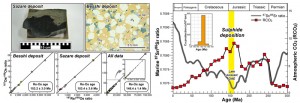Late Jurassic ocean anoxic event Evidence from voluminous sulphide deposition and preservation in the Panthalassa

The historically productive Besshi-type sulfide deposits in the Japanese accretionary complex were formed as volcanogenic massive sulfide deposits on the deep-sea floor of the Panthalassa Ocean and these deposits were a major source of copper during the development of modern Japan over approximately three centuries until the 1970s.

© Kato Lab. and JAMSTEC. Representative photograph/photomicrograph of Besshi-type sulfide ore and Re-Os isochron. Eleven Re-Os ages of Besshi-type deposit in the Sanbagawa Belt are ca. 150 Ma which synchronized with the lowest marine 87Sr/86Sr ratio and highest atmospheric CO2 concentration over the past 300 Myr (RCO2: mass ratio of atmospheric CO2 compared to present).
Professor Yasuhiro Kato, Dr. Tatsuo Nozaki (The University of Tokyo) and Dr. Katsuhiko Suzuki (Japan Agency for Marine-Earth Science and Technology, JAMSTEC) successfully obtained eleven well-defined Re-Os isochrons of the Besshi-type sulfide deposits in the Sanbagawa Belt, Japan and all isochrons yielded an Re-Os age of ca. 150 Ma in the Late Jurassic. These Re-Os ages revealed that a sequence of geological processes most likely occurred in the Late Jurassic period as follows: (1) vigorous volcanic and hydrothermal activity at the mid-ocean ridge → (2) voluminous hydrothermal sulfide deposition on the pelagic paleo-seafloor and rise of atmospheric CO2 concentration → (3) disappearance of ice sheets in the polar region → (4) subdued ocean circulation → (5) development of global ocean anoxia → (6) preservation of seafloor hydrothermal sulfide and petroleum deposits without dissolution into seawater.
This is the first strong evidence for the development of global ocean anoxia in the Late Jurassic and the breakthrough result demonstrating a very close genetic relationship between mineral/petroleum resource formations and paleocean environmental changes. Moreover, the geochronological constraints obtained here can provide a new exploration guide for undiscovered Besshi-type sulfide deposits in accretionary complexes all over the world.
Paper
Tatsuo Nozaki, Yasuhiro Kato, Katsuhiko Suzuki,
“Late Jurassic ocean anoxic event: evidence from voluminous sulphide deposition and preservation in the Panthalassa”,
Scientific Reports Online Edition: 2013/5/28 (Japan time), doi: 10.1038/srep01889.
Article link
Links
Graduate School of Engineering
Frontier Research Center for Energy and Resources (FRCER), Graduate School of Engineering
Kato Laboratory, Graduate School of Engineering (Japanese)
Japan Agency for Marine-Earth Science and Technology (JAMSTEC)






